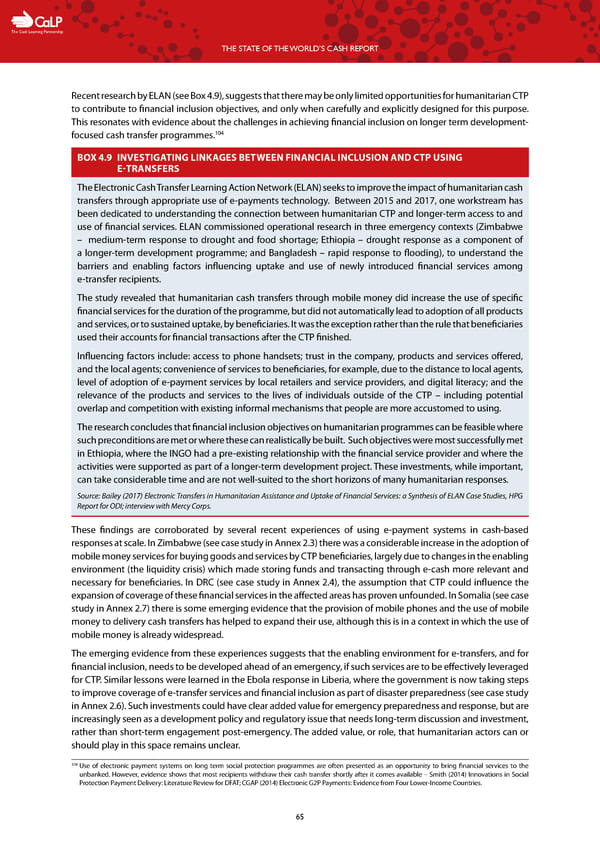C The Cash Learning Partnership THE STATE OF THE WORLD’S CASH REPORT Recent research by ELAN (see Box 4.9), suggests that there may be only limited opportunities for humanitarian CTP to contribute to financial inclusion objectives, and only when carefully and explicitly designed for this purpose. This resonates with evidence about the challenges in achieving financial inclusion on longer term development- 104 focused cash transfer programmes. BOX 4.9 INVESTIGATING LINKAGES BETWEEN FINANCIAL INCLUSION AND CTP USING E-TRANSFERS The Electronic Cash Transfer Learning Action Network (ELAN) seeks to improve the impact of humanitarian cash transfers through appropriate use of e-payments technology. Between 2015 and 2017, one workstream has been dedicated to understanding the connection between humanitarian CTP and longer-term access to and use of financial services. ELAN commissioned operational research in three emergency contexts (Zimbabwe – medium-term response to drought and food shortage; Ethiopia – drought response as a component of a longer-term development programme; and Bangladesh – rapid response to flooding), to understand the barriers and enabling factors influencing uptake and use of newly introduced financial services among e-transfer recipients. The study revealed that humanitarian cash transfers through mobile money did increase the use of specific financial services for the duration of the programme, but did not automatically lead to adoption of all products and services, or to sustained uptake, by beneficiaries. It was the exception rather than the rule that beneficiaries used their accounts for financial transactions after the CTP finished. Influencing factors include: access to phone handsets; trust in the company, products and services offered, and the local agents; convenience of services to beneficiaries, for example, due to the distance to local agents, level of adoption of e-payment services by local retailers and service providers, and digital literacy; and the relevance of the products and services to the lives of individuals outside of the CTP – including potential overlap and competition with existing informal mechanisms that people are more accustomed to using. The research concludes that financial inclusion objectives on humanitarian programmes can be feasible where such preconditions are met or where these can realistically be built. Such objectives were most successfully met in Ethiopia, where the INGO had a pre-existing relationship with the financial service provider and where the activities were supported as part of a longer-term development project. These investments, while important, can take considerable time and are not well-suited to the short horizons of many humanitarian responses. Source: Bailey (2017) Electronic Transfers in Humanitarian Assistance and Uptake of Financial Services: a Synthesis of ELAN Case Studies, HPG Report for ODI; interview with Mercy Corps. These findings are corroborated by several recent experiences of using e-payment systems in cash-based responses at scale. In Zimbabwe (see case study in Annex 2.3) there was a considerable increase in the adoption of mobile money services for buying goods and services by CTP beneficiaries, largely due to changes in the enabling environment (the liquidity crisis) which made storing funds and transacting through e-cash more relevant and necessary for beneficiaries. In DRC (see case study in Annex 2.4), the assumption that CTP could influence the expansion of coverage of these financial services in the affected areas has proven unfounded. In Somalia (see case study in Annex 2.7) there is some emerging evidence that the provision of mobile phones and the use of mobile money to delivery cash transfers has helped to expand their use, although this is in a context in which the use of mobile money is already widespread. The emerging evidence from these experiences suggests that the enabling environment for e-transfers, and for financial inclusion, needs to be developed ahead of an emergency, if such services are to be effectively leveraged for CTP. Similar lessons were learned in the Ebola response in Liberia, where the government is now taking steps to improve coverage of e-transfer services and financial inclusion as part of disaster preparedness (see case study in Annex 2.6). Such investments could have clear added value for emergency preparedness and response, but are increasingly seen as a development policy and regulatory issue that needs long-term discussion and investment, rather than short-term engagement post-emergency. The added value, or role, that humanitarian actors can or should play in this space remains unclear. 104 Use of electronic payment systems on long term social protection programmes are often presented as an opportunity to bring financial services to the unbanked. However, evidence shows that most recipients withdraw their cash transfer shortly after it comes available – Smith (2014) Innovations in Social Protection Payment Delivery: Literature Review for DFAT; CGAP (2014) Electronic G2P Payments: Evidence from Four Lower-Income Countries. 65
 The State of the World's Cash | Full Report Page 66 Page 68
The State of the World's Cash | Full Report Page 66 Page 68